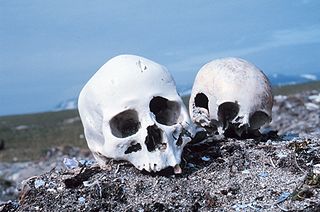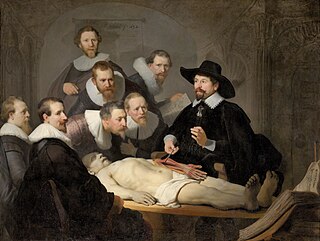
Forensic science, also known as criminalistics, is the application of science to criminal and civil laws, mainly—on the criminal side—during criminal investigation, as governed by the legal standards of admissible evidence and criminal procedure. Forensic Science is a broad field including a multitude of practices including those like DNA analysis, fingerprint analysis, blood stain pattern analysis, firearms examination and ballistics, drug chemistry, and others.

Pathology is the study of the causes and effects of disease or injury. The word pathology also refers to the study of disease in general, incorporating a wide range of biology research fields and medical practices. However, when used in the context of modern medical treatment, the term is often used in a narrower fashion to refer to processes and tests that fall within the contemporary medical field of "general pathology", an area which includes a number of distinct but inter-related medical specialties that diagnose disease, mostly through analysis of tissue and human cell samples. Idiomatically, "a pathology" may also refer to the predicted or actual progression of particular diseases, and the affix pathy is sometimes used to indicate a state of disease in cases of both physical ailment and psychological conditions. A physician practicing pathology is called a pathologist.

Anatomical pathology (Commonwealth) or Anatomic pathology (U.S.) is a medical specialty that is concerned with the diagnosis of disease based on the macroscopic, microscopic, biochemical, immunologic and molecular examination of organs and tissues. Over the last century, surgical pathology has evolved tremendously: from historical examination of whole bodies (autopsy) to a more modernized practice, centered on the diagnosis and prognosis of cancer to guide treatment decision-making in oncology. Its modern founder was the Italian scientist Giovan Battista Morgagni from Forlì.

Forensic pathology is pathology that focuses on determining the cause of death by examining a corpse. A post mortem examination is performed by a medical examiner or forensic pathologist, usually during the investigation of criminal law cases and civil law cases in some jurisdictions. Coroners and medical examiners are also frequently asked to confirm the identity of remains.

Positional asphyxia, also known as postural asphyxia, is a form of asphyxia which occurs when someone's position prevents the person from breathing adequately. People may die from positional asphyxia accidentally, when the mouth and nose are blocked, or where the chest may be unable to fully expand.

An autopsy is a surgical procedure that consists of a thorough examination of a corpse by dissection to determine the cause, mode, and manner of death; or the exam may be performed to evaluate any disease or injury that may be present for research or educational purposes. For animals, the term necropsy is generally reserved.
Frederick Thomas Zugibe was the chief medical examiner of Rockland County, New York from 1969 to 2002. Zugibe was known for his research and books on forensic medicine as well as his crucifixion and Shroud of Turin studies.

The medical examiner is an appointed official in some American jurisdictions who is trained in pathology that investigates deaths that occur under unusual or suspicious circumstances, to perform post-mortem examinations, and in some jurisdictions to initiate inquests.
Forensic medicine is a broad term used to describe a group of medical specialties which deal with the examination and diagnosis of individuals who have been injured by or who have died because of external or unnatural causes such as poisoning, assault, suicide and other forms of violence, and apply findings to law. Forensic medicine is a multi-disciplinary branch which includes the practice of forensic pathology, forensic psychiatry, forensic dentistry, forensic radiology and forensic toxicology. There are two main categories of forensic medicine; Clinical forensic medicine; Pathological forensics medicine, with the differing factor being the condition of the patients. In clinical forensic medicine it is the investigation of trauma to living patients, whereas pathological forensic medicine involves the examination of traumas to the deceased to find the cause of death.
Erotic asphyxiation is the intentional restriction of oxygen to the brain for the purposes of sexual arousal. The term autoerotic asphyxiation is used when the act is done by a person to themselves. Colloquially, a person engaging in the activity is sometimes called a gasper. Erotic asphyxiation can lead to accidental death due to asphyxia.

Medical jurisprudence or legal medicine is the branch of science and medicine involving the study and application of scientific and medical knowledge to legal problems, such as inquests, and in the field of law. As modern medicine is a legal creation, regulated by the state, and medicolegal cases involving death, rape, paternity, etc. require a medical practitioner to produce evidence and appear as an expert witness, these two fields have traditionally been interdependent.
Oral Surgery, Oral Medicine, Oral Pathology, and Oral Radiology is a monthly peer-reviewed medical journal that covers research in oral surgery, medicine, pathology, radiology, and endodontics published by Mosby. It was originally established as Oral Surgery, Oral Medicine, and Oral Pathology in 1948, changing its name to Oral Surgery, Oral Medicine, Oral Pathology, Oral Radiology, and Endodontology in 1995, and acquiring its current name in 2012. It is an official journal of the American College of Oral and Maxillofacial Surgery, American Academy of Oral and Maxillofacial Radiology, American Academy of Oral Medicine, and the American Academy of Oral and Maxillofacial Pathology. According to the Journal Citation Reports, the journal has a 2020 impact factor of 2.589.

The Journal of Clinical Pathology (JCP) is a peer-reviewed medical journal covering all aspects of pathology, published by the BMJ Group and co-owned by the Association of Clinical Pathologists. Diagnostic and research areas covered include histopathology, virology, haematology, microbiology, cytopathology, chemical pathology, molecular pathology, forensic pathology, dermatopathology, neuropathology, and immunopathology. Each issue contains reviews, original articles, short reports, case reports, correspondence, and book reviews.

The Journal of Forensic Sciences (JFS) is a bimonthly peer-reviewed scientific journal is the official publication of the American Academy of Forensic Sciences, published by Wiley-Blackwell. It covers all aspects of forensic science. The mission of the JFS is to advance forensic science research, education and practice by publishing peer-reviewed manuscripts of the highest quality. These publications will strengthen the scientific foundation of forensic science in legal and regulatory communities around the world.
The American Journal of Biological Anthropology is a peer-reviewed scientific journal and the official journal of the American Association of Biological Anthropologists. It was established in 1918 by Aleš Hrdlička.

Suicide by hanging is the intentional killing of oneself (suicide) via suspension from an anchor-point such as an overhead beam or hook, by a rope or cord or by jumping from a height with a noose around the neck.

Pirogov Russian National Research Medical University is a medical higher education institution in Moscow, Russia founded in 1906. It is fully accredited and recognized by Russia's Ministry of Education and Science and is under the authority of the Ministry of Health and Social Development. Named after Russian surgeon and pedagogue N.I. Pirogov (1810-1888).. In 2023 US News & World Report ranked it # 1,705 in the world.

Idupuganti Bhooshana Rao was a leading figure in forensic medicine in India. He was the Founding-President of the Indian Academy of Forensic Medicine established in 1972. He was born in Dornakal, Andhra Pradesh, India.
Dr. Marcella Farinelli Fierro is a medical examiner and forensic pathologist. She was the former chief medical examiner of Virginia, appointed in 1994 and serving in this position until her retirement in 2008. She was the ninth woman certified in forensic pathology by the American Board of Pathology. Since retirement, Fierro has served as an educator, mentor, and adviser.












